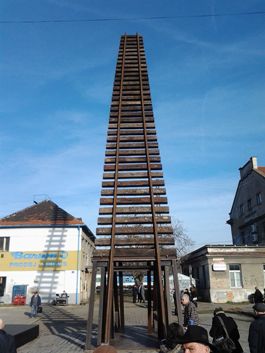
The Silence Memorial will start to be built in the spring, and it is expected to be completed in 2018
 |
"We have all the permits; this year we finally received the zoning decision and building permit. We have a prepared project and the mentioned schedule, which depends on financing. We are negotiating financing with the Ministry of Culture, which is ready to support it," he said. According to him, the entire reconstruction of the already non-functional station, plus a permanent exhibition and educational program, should cost around 125 million crowns, with the reconstruction of the building itself estimated at about 60 to 65 million.
The Memorial of Silence is primarily being created because, according to its initiators, Prague is one of the few European capitals that does not commemorate the victims of the Holocaust in public space. "We have a dignified memorial for the deceased who did not return from transports, which are the names on the wall of the Pinkas Synagogue. But Prague lacks a center where these issues can be discussed," Štingl said earlier.
The study for the reconstruction of the building is being prepared by the architectural office of Romana Koucký. The project is ensured by the Deltaplan studio. A monumental sculptural work by Aleš Veselý, "Gateway of No Return," which refers to the transports, has been drawing attention to the future memorial since last year.
For several years now, the train station has hosted theatrical and musical performances or exhibitions that also highlight the forthcoming memorial. Today, the exhibition "Paths of Silence" begins, showcasing the current forms of the places where Jewish transports departed.
Karel Cudlín captured in photographs Baluty, the central district of the city of Łódź, where up to 200,000 Jews waited for death during World War II. The photos depict crumbling houses, strange figures, and derogatory graffiti with anti-Semitic content. Richard Homola has been photographing fragments of inscriptions on the walls and beams of the former ghetto in Terezin for several years. Matěj Stránský is the author of images from Auschwitz, which he presents as a modern visitor center with lines at the factory of mass murder.
The fourth author is Pavel Dias, whose grandfather survived the war and the Buchenwald camp. Dias began photographing this subject in the 1960s, capturing the first returns of survivors to the places where they experienced their wartime martyrdom.
Sunday, October 16, marks the 75th anniversary of the first Jewish transport from Prague. The second annual event "Drumming for Bubny" will take place. Drumming will be done against the silence that has historically been able to cover even the greatest crimes, and in memory of the tens of thousands of people who departed from the Bubny train station to their deaths.
The English translation is powered by AI tool. Switch to Czech to view the original text source.
0 comments
add comment
Related articles
0
29.01.2025 | The government will soon decide on the Prague-Bubny station, expects the director of the memorial Šulcová
2
23.07.2024 | The signatories request to preserve the project for the reconstruction of the Bubny train station into the Memorial of Silence
0
24.01.2022 | The Minister of Culture will inform the government about the Monument of Silence
1
25.06.2020 | MK will submit a proposal to the government for the establishment of its organization Memorial of Silence
6
21.04.2020 | The Memorial to Silence in Bubny should be managed by the Ministry of Culture
8
30.05.2019 | The Silence Memorial at Bubny station should be completed in 2021
0
22.08.2018 | The reconstruction of the station in Bubny into a Holocaust memorial will begin in September
0
21.09.2017 | In the future Memorial of Silence, an art gallery was created
2
09.03.2015 | The statue at Bubny train station commemorates the transports
0
20.01.2015 | The exhibition in New Town presents the Holocaust museum project
0
27.10.2014 | The exhibition presents a future memorial at the station in Bubny





